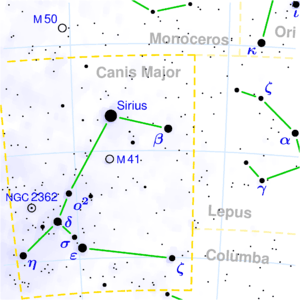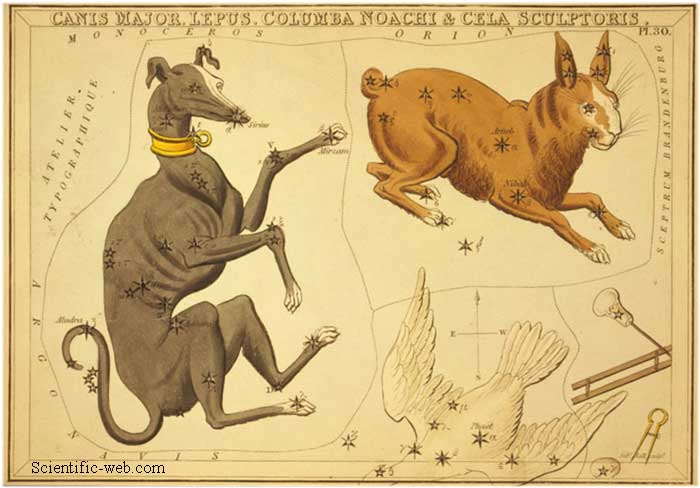|
|
Canis Major ( Latin: greater dog) is one of the 88 modern constellations, and was also in Ptolemy's list of 48 constellations. It is said to represent one of the dogs following Orion the hunter (see also the constellations of Orion, Canis Minor, and Canes Venatici.) Canis Major contains Sirius, the brightest star in the night sky, and that star is part of what is called the Winter Triangle in the Northern Hemisphere, or the Summer Triangle in the Southern. Notable features Canis Major's alpha star, Sirius, is the brightest star besides the Sun, Moon, Jupiter, and Venus as seen from Earth. It is also one of the nearest. The star's name means scorching, since the summer heat occurred just after Sirius' heliacal rising. The Ancient Greeks referred to such times in the summer as dog days, as only dogs would be mad enough to go out in the heat, leading to the star being known as the Dog Star. Consequently, the constellation was named after it, as a Big Dog. There are several other fairly bright stars in Canis Major, all with Arabic names: * β CMa: (1.98v) Murzim - The Announcer * γ CMa: (4.11) Muliphen * δ CMa: (1.83) Wezen - The Weight * ε CMa: (1.51v) Adhara - Virgins * ζ CMa: (3.02) Furud - Bright Single One * η CMa: (2.45v) Aludra - the virgin Muliphen is the Arabic rendering of the Greek for "dog's ear". Notable deep sky objects There are not many bright deep sky objects in this region of sky. The only Messier object in Canis Major is Messier 41 (NGC 2287), an open cluster of visual magnitude 4.6. It is located about 4 degrees directly south of Sirius. Messier 41 is roughly 2350 light years away from Earth, contains about 8,000 stars, and is about 24 light years in diameter. It is also noted for containing a number of K-class stars. The band of the Milky Way goes through Canis Major and therefore background galaxies are hidden behind interstellar dust clouds. However, in 2003, Canis Major Dwarf, the closest satellite galaxy to Earth was found within the constellation. Mythology This constellation was known to the easterners from the time immemorial. In early European classical days, this constellation represented Laelaps, gift from Zeus to Europa; or sometimes the hound of Procris, Diana's nymph; or the one given by Aurora to Cephalus, so famed for its speed that Zeus elevated it to the sky. Most commonly, Canis Major (or perhaps just the star Sirius) is Orion's hunting dog, pursuing Lepus the Hare or helping Orion fight Taurus the Bull, and is referred to in this way by Aratos, Homer and Hesiod. The ancient Greeks refer only to one dog, but by Roman times, Canis Minor appears as Orion's second child. Roman myth also refers to Canis Major as Custos Europae, the dog guarding Europa but failing to prevent her abduction by Jupiter in the form of a bull; and as Janitor Lethaeus, the watchdog of Hell. Depending on the faintness of stars considered, Canis Major resembles a dog facing either above or below the ecliptic. When facing below, since Sirius was considered a dog in its own right, early Greek mythology sometimes considered it to be two headed. As such, together with the area of the sky that is deserted (now considered as the new and extremely faint constellations Camelopardalis and Lynx), and the other features of the area in the Zodiac sign of Gemini (i.e. the Milky Way, and the constellations Gemini, Orion, Auriga, and Canis Minor), this may be the origin of the myth of the cattle of Geryon, which forms one of The Twelve Labours of Heracles. Sirius was an object of wonder and veneration to all ancient peoples throughout human history. In the ancient Vedas this star was known as the Chieftain's star; in other Hindu writings, it is referred to as Sukra, the Rain God, or Rain Star. The Dog is also described as "he who awakens the gods of the air, and summons them to their office of bringing the rain." Sirius was revered as the Nile Star, or Star of Isis, by the ancient Egyptians. Its annual appearance just before dawn at the Summer Solstice, June 21, heralded the coming rise of the Nile, upon which Egyptian agriculture depended. This helical rising is referred to in many temple inscriptions, where the star is known as the Divine Sepat, identified as the soul of Isis. In the temple of Isis-Hathor at Dedendrah, Egypt, appears the inscription, "Her majesty Isis shines into the temple on New Year's Day, and she mingles her light with that of her father on the horizon." The Arabic word Al Shi'ra resembles the Greek, Roman, and Egyptian names suggesting a common origin in Sanskrit, in which the name Surya, the Sun God, simply means the "shining one." Canis Major, Lepus, Columba Noachi and Cela Sculptoris References * Ian Ridpath and Wil Tirion (2007). Stars and Planets Guide Links
Retrieved from "http://en.wikipedia.org/"
|
|
||||||||||||


